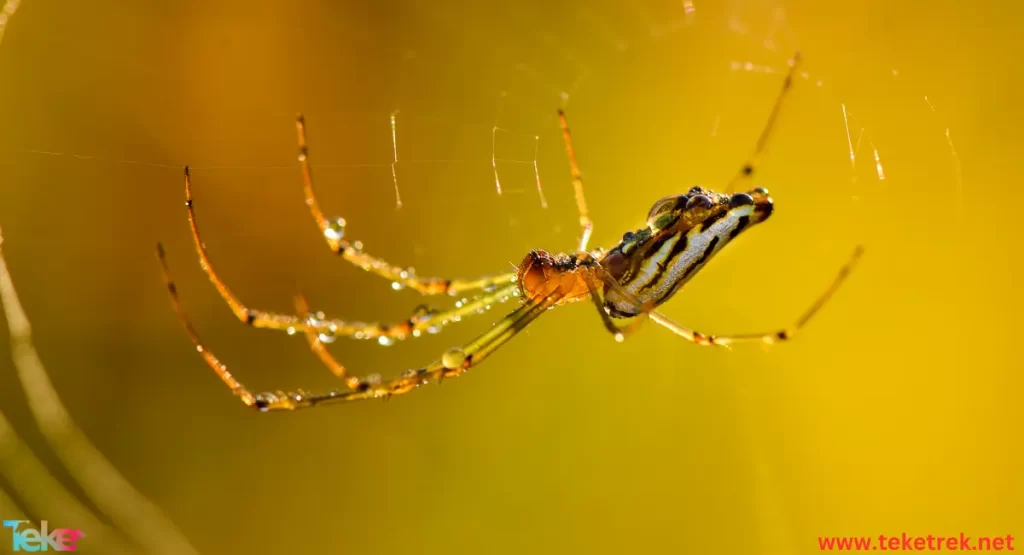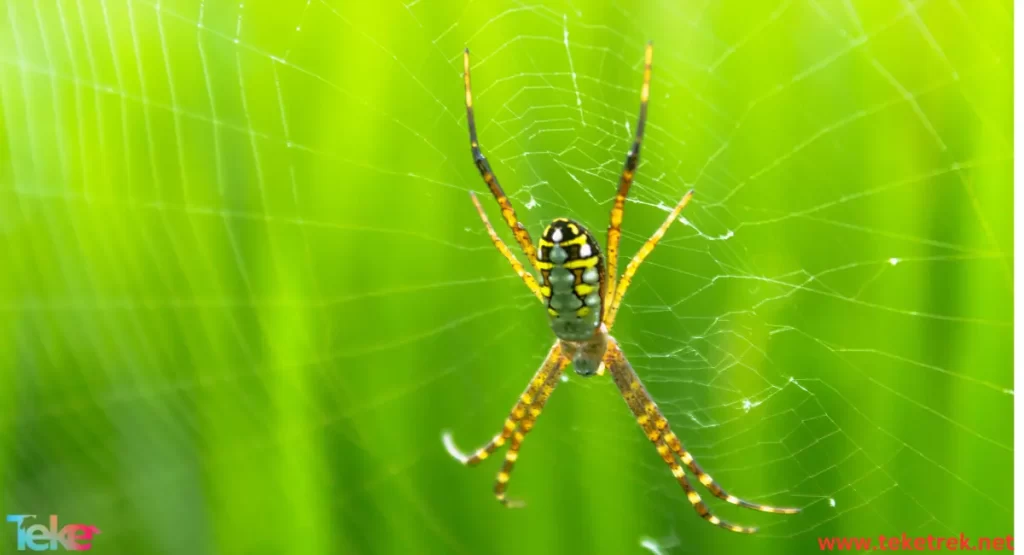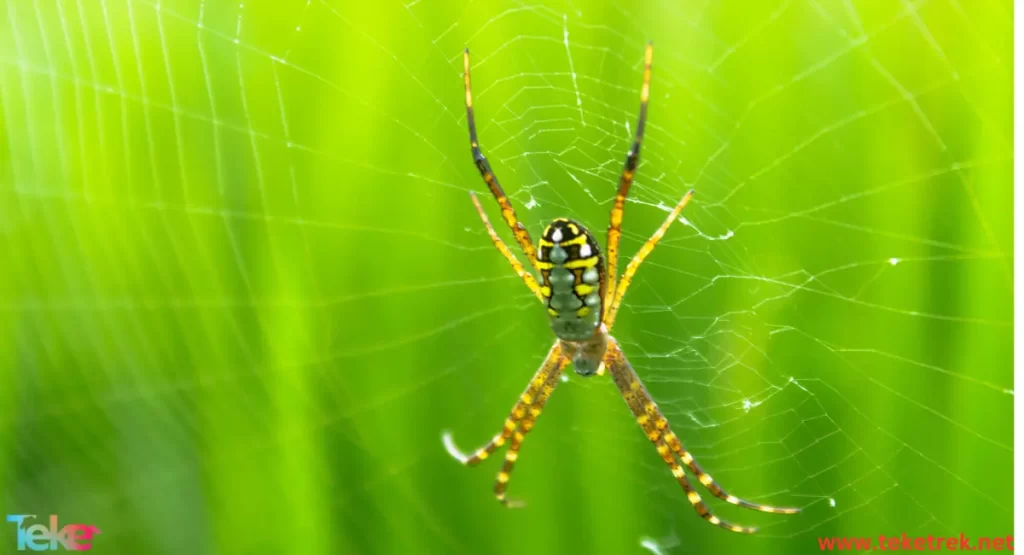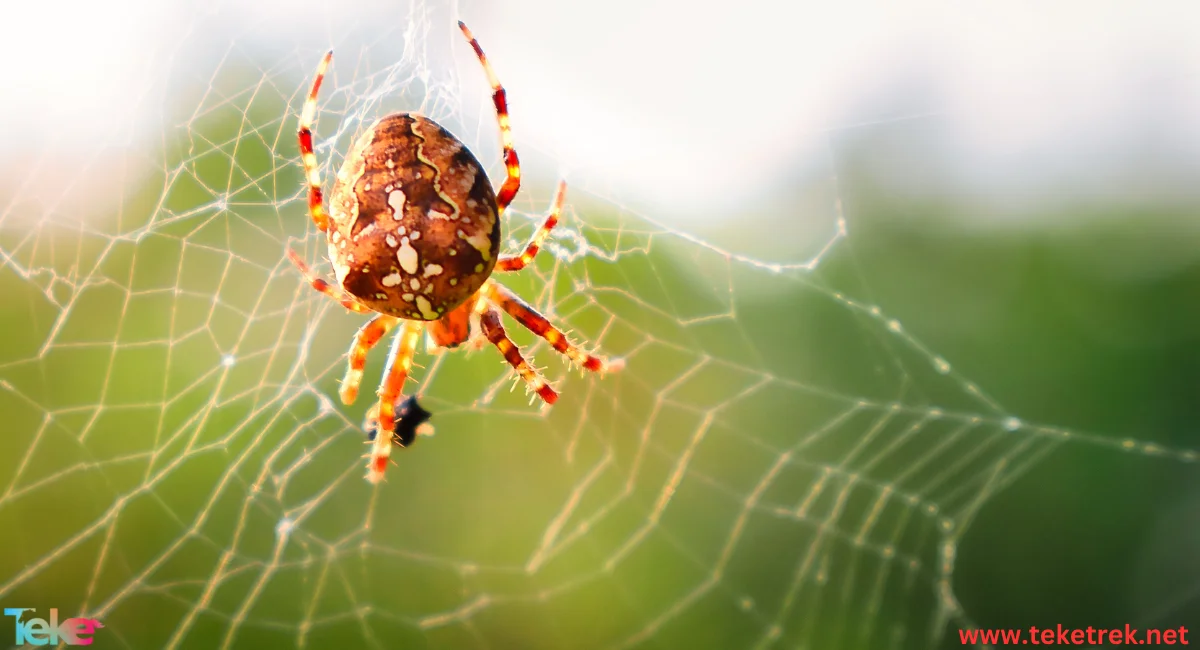Spiders, those fascinating yet eerie creatures, possess a charm and mystery that evoke both curiosity and fear at the same time. They wield a unique weapon unparalleled in the entire animal kingdom: spider silk, which they use to ensnare their prey.
Spiders are considered an essential part of the diversity of life on planet Earth, as they inhabit various terrestrial and aquatic environments, exhibiting significant diversity in their species. From Teketrek we will talk more about it.
Describe the spider
The spider belongs to arthropods,
- The spider’s body consists of two main parts: the cephalothorax and the abdomen. The cephalothorax carries the eyes, fangs, and legs, while the abdomen holds the internal organs, venom glands, and reproductive glands.
- The abdomen contains systems such as the circulatory, digestive, reproductive, and respiratory systems, as well as silk glands.
- Spiders typically have eight legs.
- As for the eyes, spiders can have multiple eyes, ranging in number from 2 to 12, depending on the species and family.
- Some spiders have very small eyes that may not be visible to the naked eye, while others have larger eyes that are visible.
- Spiders weave a network of threads to capture their prey. They do not belong to the insect class but rather to the arachnid class, which is a branch of the arthropods.

- The spider’s mouth consists of two strong fangs used for grasping food and injecting venom into the prey. Venom glands are located at the base of the fangs and secrete venom that becomes dangerously toxic to the prey.
- The colors of spiders vary between black, brown, gray, yellow, red, orange, green, and white. Some species may have distinctive patterns and markings on their bodies.
- The size of spiders varies greatly among different species, ranging from very small sizes in spiders like mites to large sizes in spiders such as tarantulas and orb-weavers.
- Fine and delicate hairs cover the spider’s body, providing it with sensory input, aiding in balance, and enabling the spider to move effectively.
- Spider webs vary greatly in size, shape, and the amount of adhesive material on the threads used.
- It’s the female spider that typically constructs the web. The number of threads can reach up to 400,000, with each thread being approximately 20 cm in length.
- Spiders possess venom glands that they use for self-defense and capturing prey. They inject venom into their prey to immobilize and predigest it before consuming it.
strange information and Intertsting six Ten facts about spiders
- Some species of spiders have an amazing ability to build a spider web in a very short time, with some species able to construct their web in just one hour.
- some types of Spider can fly. Flying Spider can jump from a high place using their spider silk and glide distances of several meters.
- Spiders are among the most precise hunters in the world. They construct traditional spider webs and patiently wait in silence until they accurately capture their prey.
- Some species of orb-weaver spiders can be massive in size, with the diameter of some webs built by these spiders reaching over one meter.
- There are over 45,000 known species of spiders worldwide, meaning there is a large and diverse range of shapes, sizes, colors, and behaviors among different species.
- Some spiders can produce venoms that effectively poison their prey without causing physical harm, allowing them to capture prey without putting themselves in danger.
- Spider silk is extremely resilient, to the extent that it’s used to make violin strings. When in contact with water, silk becomes even stronger.
- Spiders have antennae, although their vision is not sufficient. However, they use their sensitive leg touch to navigate themselves with environmental scents, and thanks to their four pairs of eyes, they can observe different positions simultaneously, albeit at a short distance.
- Spiders can sense vibrations around them, especially when detecting trapped prey in their web.
- Spider also emit a special chemical substance, which is taken either as a warning or a competitive signal, or in some cases, to determine if the female is ready to mate.
- Spider can sense temperature, aiding them in finding shelter more easily.
- Spider venom is a common compound in medications that treat erectile dysfunction.
- Spiders have a strong sense of smell, and the sensitive hairs on their legs and other parts of their bodies can pick up odors.
- Spider initially weave their web with dry threads. As they near completion, they use sticky threads, allowing them to roam around the web without getting stuck.
- Spider don’t use external materials in their construction; instead, they spin their threads from a fluid secreted by the female’s glands in her body.
- Spider don’t build their webs randomly or haphazardly; instead, they construct their webs according to precise calculations. Therefore, not all spider webs are identical.
The habitat and living places of spider
- Spiders can live anywhere there is sufficient food available for them, spanning across all continents. They can be found in fields, forests, swamps, desert environments, and even inside caves.
- There is a type of spider that spends most of its life underwater.
- Another type is known to inhabit areas near the summit of Mount Everest, the tallest mountain in the world.
- Some species reside indoors, in houses, warehouses, and abandoned buildings, while others dwell on building walls, ceilings, windows, and doors.
- Spiders live in all climates and at all altitudes, making them incredibly adaptable creatures.
Spider species
There are more than 40,000 species of spiders that can be found in nature all around the world. To make it easier to study and understand their characteristics, spiders have been classified into different groups.
- Segmented Spider:
Segmented spiders, scientifically known as Mesothelae, are ancient species that prevailed in prehistoric eras. They had a large size, with their head estimated to be as big as a human head.
- Modern Spider:
Modern spiders have small, distinctive bodies divided at the abdomen, similar to the body of a scorpion. They also possess spinnerets at the rear of the abdomen.
- Black Widow Spider:
Their shiny black color, with an hourglass-like shape on the underside of the abdomen, characterizes these spiders.
- Brown Recluse Spider:
Their distinctive brown color, which noticeably darkens on the back region, distinguishes these spiders.
Spider food
- They feed on various types of insects such as flies, mosquitoes, butterflies, bees, ants, and mites.
- Hunting spiders typically prey on larger insects such as grasshoppers, beetles, and cockroaches.
- Some giant hunting spiders, like the Huntsman spider, are capable of capturing lizards and frogs.
- Certain spiders are known to have preferences for specific types of food. For example, the white-tailed spider prefers to consume other spiders and rarely seeks out alternative food sources.
Spider life cycle
- Spiders undergo reproduction through indirect sexual reproduction and internal fertilization. In this process, the male spider does not directly introduce sperm into the female spider’s body using its reproductive organs. Instead, an intermediary stage facilitates this.
- Male spiders deposit sperm into a special silk web they create. The female then draws it into her genital openings using her pedipalps, storing it inside her. She selects the capable and suitable sperm for fertilizing the eggs.
- Spiders complete their life cycle by laying approximately 1,000 to 3,000 fertilized eggs in a silk sac after mating, maintaining the eggs at a consistent level of moisture.
- The life cycle of spiders consists of three main stages:
- Egg Protection Stage:
This stage occurs immediately after mating, where the female spider preserves the eggs in a sturdy silk sac to protect them from environmental conditions.
- Pre-Adolescence Stage:
This stage begins after all the eggs have hatched into spiderlings. The spiderlings disperse from each other by walking or through ballooning, where they release silk threads to catch the wind and float away.
- Adolescence Stage:
The spider matures sexually during adolescence, initiating a new life cycle through mating. Spider lifespans vary among species, but they typically live for around one to two years.


FAQ
One of the most common questions about spiders
- What is the characteristics of spider?
A spider is an animal from the arthropod phylum. It has 8 legs and 4 pairs of eyes. It captures its prey using strong threads of natural fibers.
- What are the benefits of spider?
The spider helps kill insects in the home, including cockroaches and mosquitoes.
- When does a spider die?
The spider dies when it smells citrus scents.
- Where does the spider live?
The spider lives on various continents where it has enough food. You may find it in forests, deserts, fields, swamps, and caves.
Finally, we can say that spiders are fascinating and diverse creatures, playing a crucial role in the ecosystem. Despite some spiders being venomous, most spiders are not harmful to humans. We can learn a lot about the world through studying Spider and their behaviors.






